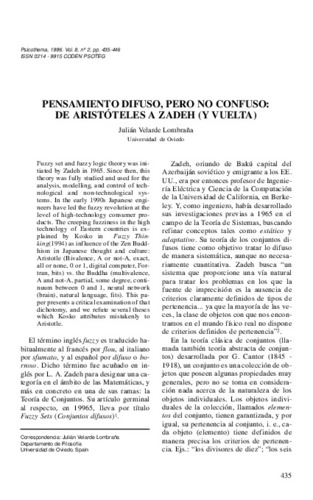Pensamiento difuso, pero no confuso: de Aristóteles a Zadeh y vuelta
Author:
Publication date:
Editorial:
Colegio Oficial de Psicólogos del Principado de Asturias
Citación:
Descripción física:
Abstract:
Fuzzy set and fuzzy logic theory was initiated by Zadeh in 1965. Since then, this theory was fully studied and used for the analysis, modelling, and control of technological and non-technological systems. In the early 1990s Japanese engineers have led the fuzzy revolution at the level of high-technology consumer products. The creeping fuzziness in the high technology of Eastern countries is explained by Kosko in Fuzzy Thinking (1994) as influence of the Zen Buddhism in Japanese thought and culture: Aristotle (Bivalence, A or not-A, exact, all or none, 0 or 1, digital computer, Fortran, bits) vs. the Buddha (multivalence, A and not-A, partial, some degree, continuum between 0 and 1, neural network (brain), natural language, fits). This paper presents a critical examination of that dichotomy, and we refute several theses which Kosko attributes mistakenly to Aristotle.
Fuzzy set and fuzzy logic theory was initiated by Zadeh in 1965. Since then, this theory was fully studied and used for the analysis, modelling, and control of technological and non-technological systems. In the early 1990s Japanese engineers have led the fuzzy revolution at the level of high-technology consumer products. The creeping fuzziness in the high technology of Eastern countries is explained by Kosko in Fuzzy Thinking (1994) as influence of the Zen Buddhism in Japanese thought and culture: Aristotle (Bivalence, A or not-A, exact, all or none, 0 or 1, digital computer, Fortran, bits) vs. the Buddha (multivalence, A and not-A, partial, some degree, continuum between 0 and 1, neural network (brain), natural language, fits). This paper presents a critical examination of that dichotomy, and we refute several theses which Kosko attributes mistakenly to Aristotle.
ISSN:
Files in this item




